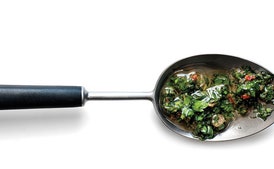
Introduction
Salsa Verde is a vibrant and flavorful condiment that has its roots in Latin American cuisine. This recipe brings the essence of freshness from herbs, spices, and citrus to your table, offering a delightful blend of tangy, slightly spicy, and savory notes.
Tips for this Recipe
– Ensure all ingredients are at room temperature before mixing.
– Use freshly chopped herbs to maximize flavor.
– If using a mortar and pestle, start with less pressure to gradually release the oils from the herbs for an authentic taste.
Why you will love this recipe
The versatility of Salsa Verde makes it perfect for dipping or as a garnish for various dishes, including grilled meats and vegetables. Its freshness not only tantalizes the palate but also adds an element of healthfulness to any meal due to its herbaceous ingredients.
Ingredients
6 oil-packed anchovy fillets, chopped (optional)
1 garlic clove, chopped
1 1/2 tablespoons capers, rinsed and chopped
1 Fresno chile or red jalapeño, stemmed, seeded, minced
4 cups loosely packed fresh flat-leaf parsley leaves, finely chopped
2 cups loosely packed fresh mint leaves, finely chopped
1 cup loosely packed fresh cilantmun leaves, finely chopped
1 cup plus 2 tablespoons extra-virgin olive oil
Kosher salt (optional)
Advised Equipments
– Kitchen Knife: For precise and safe chopping.
– Cutting Board: To protect your countertops while preparing ingredients.
– Mortar and Pestle: Traditional choice for grinding herbs.
– High-Speed Blender: For achieving a smooth salsa texture.
– Measuring Cups and Spoons: Essential for accurate proportions.
– Colander: Useful in rinsing produce before chopping.
– Digital Food Scale: Ensures precise measurements of ingredients.
– Silicone Food Bottle: Ideal for storing salsa verde after preparation.
– Glass Jar with Lid: The perfect storage solution to keep homemade salsa fresh and delicious.
– Cutting Gloves: Safety is paramount when handling sharp tools or hot ingredients.
History of the Recipe
Originating from Mexico, Salsa Verde has been a staple in Latin American cuisine for centuries. Traditionally made with tomatillos and various chili peppers, modern interpretations have embraced diverse herbs and additional ingredients such as capers to cater to different palates. Its simplicity yet depth of flavor reflects the rich culinary history it carries across generations.
Fun Facts about this Recipe
1. The word “Salsa” means sauce in Spanish, while “Verde” translates to green, highlighting the vibrant color of traditional recipes using tomatillos and cilantro.
2. While anchovies are optional, they provide a salty depth that can elevate the dish’s flavor profile if used correctly.
3. Salsa Verde is not just a condiment; it also serves as a testament to Latin American culinary traditions and their emphasis on fresh, locally-sourced ingredients.



